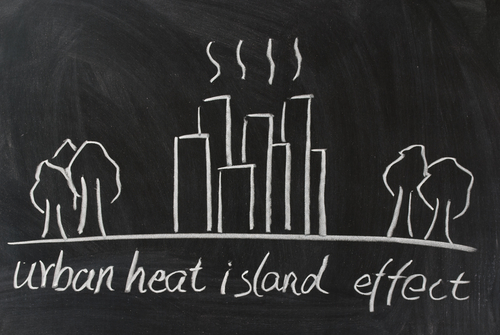 |
Anyone that has traveled directly from a rural area to an inner city area on a hot summer day has likely noticed it is usually hotter in the city, sometimes much hotter. The simple reason is that the structures and infrastructure that make a city a city, also trap heat. And the darker the structure’s surface, the more heat is absorbed. In addition, urban areas have much more human activities that contribute to UHI impacts, such as transportation, manufacturing and air conditioning use. In rural areas, however, natural surfaces are more reflective and absorb less heat, and they may also be wetter, which helps dissipate heat through evaporation.
According to the Lawrence Berkeley National Lab, roofs and paved areas can make up as much as 60% of a U.S. city and because they are usually dark, and can absorb at least 80% of sunlight. This heat does not just impact roofs, roads and parking lots, instead it is transferred to building interiors, it further warms the air moving over the surface and it radiates back into the atmosphere contributing to global warming.
Forget expensive calls to lawyers and consultants. With Enviro.BLR.com®, you get instant access, 24/7. Try it out today and get 2014 EHS Salary Guide absolutely free. Download Now.
Looking at it from another perspective, according to the Environmental Protection Agency (EPA) a city of one million people or more can have an annual mean air temperature of 1.8 – 5.4°F warmer than surrounding areas, with evening temperature differences going as high as 22°F. When temperatures soar, one of the first consequences is that air conditioning use goes up as well. Specifically, research shows that electricity demand for cooling increases 1.5 – 2.0% for each 1°F increase in air temperature, beginning at 68 t – 77°F, which the EPA says suggests that “5-10% of community-wide demand for electricity is used to compensate for the heat island effect.”
Of course this increased demand for electricity takes another toll – air pollution and greenhouse gas (GHG) emissions – especially when that demand is met by fossil-fuel burning power plants. The primary pollutants from power plants include sulfur dioxide, carbon monoxide, nitrogen oxides, particulate matter, and mercury and are not only hazardous to human health individually, they also help to form ground-level ozone or smog, fine particulate matter and acid rain, and contribute considerably to global climate change.
Everything You Need for Environmental Compliance
Enviro.BLR.com puts everything you need at your fingertips, including practical RCRA, CAA, CWA, hazardous waste regulatory analysis and activity, news, and compliance tools. Try it at no cost or risk and get a FREE report.
The human health impacts of UHIs resulting from increased daytime temperatures, decreased nighttime cooling and higher pollution levels can cause an array of problems including discomfort, heat cramps and exhaustion, heat strokes, and even death. This is particularly true during heat waves or “excessive heat events” which can result in above-average death rates. From 1979 to 2003, the Centers for Disease Control and Prevention (CDC) estimated such excessive heat events contributed to more than 8,000 premature deaths nationwide, more than all the deaths attributed to hurricanes, lightening, tornadoes, floods, and earthquakes combined during the same period.
Another type of collateral damage from UHIs is the impact that hot surfaces have on stormwater runoff. According to the EPA, pavements that are heated to 100°F can raise the temperature of initial rainwater from about 70°F to more than 95°F. Since urban stormwater typically runs off to local water bodies, it can then raise the water temperature, sometimes rapidly, affecting the metabolism and reproduction of aquatic life, and resulting in other types of stress and fatalities.
